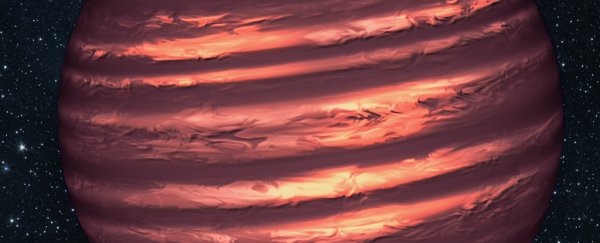A brown dwarf 6.5 light-years from Earth in the constellation of Vela could be banded like a bumblebee butt. New observations of the object seem to show stripes of clouds that circle its entire globe, similar to those on Jupiter.
It's not the first time such bands have been detected on a brown dwarf - but it is the first time astronomers have made such a detection using polarimetry, taking measurements of objects based on the way the light they emit is twisted, or polarised.
It's not a new technique, but advances in technology and analysis techniques are giving it new life as a tool for understanding our cosmos, astronomers note.
"Polarimetry is receiving renewed attention in astronomy," said astronomer Dimitri Mawet of Caltech and the Jet Propulsion Laboratory.
"Polarimetry is a very difficult art, but new techniques and data analysis methods make it more precise and sensitive than ever before, enabling groundbreaking studies on everything from distant supermassive black holes, newborn and dying stars, brown dwarfs and exoplanets, all the way down to objects in our own Solar System."
A distance of 6.5 light-years is really small in astronomical terms, but it's a long way away to try to pick out details on an object as small and dim as a brown dwarf.
Brown dwarfs are an intermediate between planets and stars, and are often called "failed stars". They form the same way stars do - from the collapse of dense knots of material in cosmic gas clouds - but they're just not quite massive enough for hydrogen fusion in their cores.
Some of them could fuse deuterium, but they run out of fuel pretty quickly compared to 'real' stars; brown dwarfs are expected to undergo a cooling and contracting process similar to white dwarfs.
However we choose to look at them, brown dwarfs are pretty weird, sitting in an oddball class all of their own - not quite a planet, not quite a star. But learning more about them can help us to understand more about stars, planets, and, of course, the brown dwarfs themselves.
It's thought that brown dwarfs don't develop atmospheric phenomena such as cloudy conditions until they are past the first blush of youth and are already starting to cool.
And this is where a brown dwarf discovered in 2013 comes in. Actually, it's two brown dwarfs - a binary brown dwarf system called Luhman 16AB. They're the closest brown dwarfs to Earth, and therefore excellent candidates to try and conduct a detailed study.
A previous study has detected what astronomers think are clouds on three other brown dwarfs, as well as one member of the binary pair, using measurements of their brightness to infer the presence of atmospheric changes. But what about bands of clouds that don't alter the overall brightness profile of the object?
So astronomer Maxwell Millar-Blanchaer of Caltech and colleagues used the European Southern Observatory's Very Large Telescope (VLT) in Chile to determine if they could make out details on one of the brown dwarfs - Luhman A - using polarimetry.
"Polarimetry is the only technique that is currently able to detect bands that don't fluctuate in brightness over time," Millar-Blanchaer said. "This was key to finding the bands of clouds on Luhman 16A, on which the bands do not appear to be varying."
The technique didn't allow the team to see the actual clouds. That would be amazing, but it's a little outside our capabilities at the present time.
Rather, the team took polarimetric measurements of the brown dwarf, and then used sophisticated modelling to try to reproduce the polarisation signature they observed. Two thick, permanent bands of clouds, like those seen on Jupiter, were a close match.
And, like Jupiter, those clouds would be roiling, turbulent weather mess machines.
"We think these storms can rain things like silicates or ammonia. It's pretty awful weather, actually," said astronomer Julien Girard of the Space Telescope Science Institute.
And the research has implications well beyond Luhman A. As our instruments continue to improve, we may be able to use polarimetry to study the atmospheres of exoplanets, looking not just for weather, but to see whether we can identify the conditions for life.
Unfortunately, we probably won't find those on brown dwarfs though.
The research has been published in The Astrophysical Journal.
